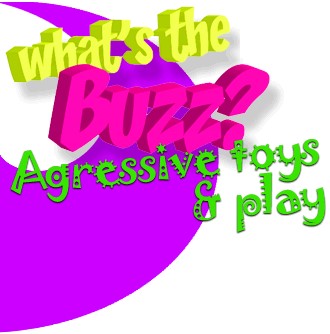
Play is a form of learning which not only stimulates a child's imagination and provides excitement, but teaches important social skills such as co-operation and self-control.
Encourage your children to play with a wide range of toys and don't worry if some of their games appear overly 'aggressive'. Aggressive games such as rough and tumble play and pretend fighting with toy guns are all part and parcel of learning to understand and imitate the adult world.
"The toy is an intermediary between the child and the world in which it lives. It is therefore the family environment far more than the toy that is the decisive factor in the child's character. Children become violent when their parents are violent or when they allow violence to go unpunished". European Parliament
What is a War Toy?
People's opinions vary enormously on this question. Is a water gun a war toy to you? Or a video game in which characters are 'attacked'?
The important point to remember is that a toy's appearance is less important than how it is used. Some toys, including toy guns, actually encourage active play which is an essential part of growing up.
Do Toys Lead To Aggression and War?
There is no evidence linking aggressive toys to children's aggression, or their attitudes towards violence. How you behave towards your child has much more influence on them than a toy - however fond of it they may be.
Neither is it true to say that children who play with military toys or toy guns will develop militarist attitudes as a consequence. If you look at the sales of war toys you'll notice that they sometimes increase after a real war, but rarely before.
In fact, contrary to what you might think, the majority of toys sold are activity toys such as building sets, toy figures and model kits. Only about 1.5% of toys sold are toy weapons.
Toy weapons today look increasingly lifelike and this is a worry to some parents. The toy industry in Britain has now adopted a policy of identifying toy guns with a brightly coloured plug in the gun barrel, so they will not be mistaken for real weapons.This is already a legal requirement in Italy and the United States.
Will Boys to Boys?
Nobody is really sure whether the differences between boys and girls are learned or inborn. In general, though, because boys are expected, and allowed, to be more aggressive than girls, it follows that their games tend to be more physical and aggressive.
Indeed, the figures in one study show that 65% of all 5-9 year old boys own a toy gun compared to only 30% of girls.* Even boys as young as 2 years of age show a preference for tanks, planes, toy guns and male action figures.
Is It Real or Pretend?
It is only natural that an extremely active child is more likely to be aggressive than a less active one. But pretending to be aggressive is not the same as being aggressive. Real fighting is something else altogether and should not be praised or encouraged.
While adults may sometimes confuse real and pretend fighting, research shows that children as young as five are able to tell the difference between real aggression, which frightens them, and aggressive play, which they see as harmless fun.
What Shall I Do for the Best?
If you disapprove of a particular toy, don't buy it. A flat refusal might make a toy seem even more attractive to a child, so be careful to explain your reasons for refusing.
Set clear guidelines for the use of toys and be consistent and firm - but not aggressive - in your disapproval of aggression. If you feel the need to compromise, you might allow your child to 'earn' the toy either by doing chores or by paying for it from an allowance.
Try to remember to participate in your children's rough and tumble play from time to time. Play is one way children have of understanding the world of adults. Be constructive, use it as an opportunity to discuss violence, guns, war and peace.

